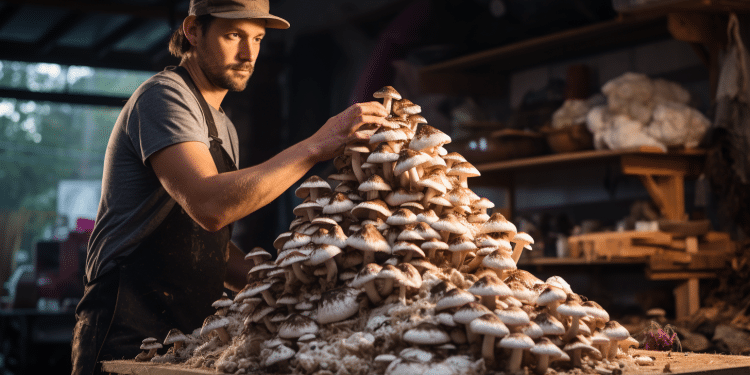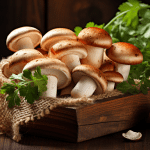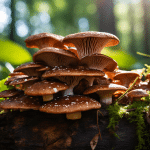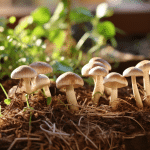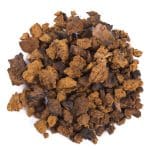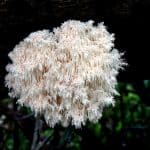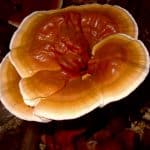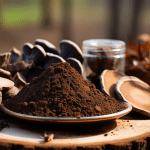To successfully grow mushrooms, you need to be sure you are using the right substrate. Using substrates for growing mushrooms is equivalent to using soil for growing plants. It is the place the mushrooms will receive all their nutrients as they grow. Just as plants need soils of varying properties, different types of mushrooms favor certain types of substrates.
By the end of this tutorial, you will learn what the substrate is in mushrooms, and its uses. You will know some of the common mushroom substrate recipes, as well as preferred substrates of various mushrooms. We also teach you how to pasteurize or sterilize your substrates, and much more.
What Is Mushroom Substrate? What is it Used For?
A mushroom substrate is the material that the mycelium grow on and set up. The substrate provides mushrooms with nutrients, water, and energy that they need in order to grow and produce. There are many different substrates used by growers.
Different species of mushrooms have their preferences. So, it is essential that you pair your mushrooms with a suitable substrate in order to get the best chances for success. You can learn more about mushroom substrates from this video:
What Makes a Good Mushroom Substrate?
- A good substrate is one that is rich in woody, fibrous materials such as lignin, cellulose, and hemicellulose.
- Your substrate needs to have 1% to 2% nitrogen for the most ideal growing environment. Most substrates (like sawdust or straw) need to have additional materials added to them to reach this threshold.
- Your substrate needs to contain a small amount of magnesium, potassium, calcium, sulfur and phosphorus. Most raw substrates already contain these minerals, but this does vary depending on where the material came from.
- You’ll likely need to experiment here to see if you need to supplement with additional minerals and nutrients.
- Your substrate needs to be slightly acidic, with a PH level of about 5 – 6.5. Just double check the ideal requirements depending on the specific mushroom you’ll be growing.
- Your substrate needs to have a good structure to enable air exchange.
- Your substrate needs a moisture content of 50-70% to create ideal conditions.
- Finally, your substrate needs to have an absence of competing organisms. This provides a blank canvas for your mushroom mycelium to thrive.
Learn more: Mushroom spawn
Preparing Substrate
Before the substrate can be contaminated by fungus spores or mycelium, first, it must be prepared. Water will need to be added to the substrate, and it may need to be amended with additional nutrients as well. Once this is done, the substrate needs to be sterilized or pasteurized.
This eliminates any competing moulds or bacteria, and gives your desired species of mushrooms their best shot to establish and grow. The substrate for mushrooms can be placed into various containers. For commercial growers, the most common is to package the substrate into large, clear plastic bags.
Home gardeners can make their own jars of mushroom substrate, using mason jars or other smaller containers, or they can pack the substrate in buckets.
Once your substrate is pasteurized or sterilized and in the final container, it is time to inoculate it with fungi starter cultures, or spores, to begin the growing process.
You will know that things are going well when you begin to see signs of colonization, or when mushroom mycelium grows and disperses through your substrate. The mycelium will take weeks, and possibly months, to decompose the substrate and fully expand through it. Once the colonization is fully complete, the entire substrate will be covered with mycelium. At this point, it is ready for harvest.
Common Mushroom Substrate Materials (and Mushroom Substrate Recipes)
There is a vast array of materials you can use as your mushroom growing substrate. Some are pretty common, and others are a little more novel and experimental. Here are some of the more common substrates currently used by mushroom farmers.
Coffee grounds
We started out growing coffee grounds, and have been doing that for years. If you reach out to your local coffee shops, they will often keep the spent coffee grounds and provide them for you free of charge. One big advantage is that the process of making coffee will pasteurize the grounds, so you can begin growing on them almost immediately. The coffee grounds growing recipes are some of the easiest as well.
Simply mix a pound of coffee grounds with 100 grams of fungus starter. You can optionally add 20% straws to the mixture to allow better air exchange and higher rates of colonization.
Straw
Straw is another inexpensive, efficient material for using as your base. It can be purchased from farmers markets or most places that sell feed or animal bedding.
You may also experiment with similar agricultural wastes, such as cornstalks. You may either grow on a 100% straw-based substrate, or add supplements for extra nutrients. There are a few methods that you can use for making your own straw substrate.
Many people use chemicals such as peroxide or calcium hydroxide, or they rely on fermentation of straws over the course of a week or longer. We prefer using a heat treatment that is both fast and organic.
Start by cutting the straws into three- to four-inch pieces. If you are working with a lot of straw, using a trash-bin grass-cutter can make quick work of the stuff. To pasteurize your straw, place it into a washcloth or pillowcase and soak in 160-degree-F water for an hour.
On a smaller scale, you can do it at home over the stovetop. For larger operations, a 55-gallon drum and a butane burner are used.
Once you have finished making the bales, you will want to get it drained very well. When squeezing out a small amount of your mushroom growing substrate, there should only be a few drops of water coming out. At this point, it is ready for the fungus to spawn.
Coco Coir and Vermiculite
Coco-coir is a material made from the ground-up coconut shells and husks. It is available to buy at most gardening stores. Vermiculite is a yellowish-brown mineral used for retaining moisture, which is also commonly available at garden centers around the world. Mixing the two materials together can make a perfect substrate to grow a few types of mushrooms. Most recipes call for a portion of coco coir and one portion of vermiculite.
For one standard brick of dried coco coir (about 1.5 pounds), add eight cups of dried vermiculite, plus 16 cups boiling water. Soak the materials in a five-gallon bucket for about one hour. Then stir it all together, return lid, and let it cool for four hours before sprinkling with inoculation. Keep in mind, coco coir expands by five or seven times its volume when added water, so you will eventually have much more substrate than initially looked.
Hardwood Pellets
All forms of hardwood, such as maple, oak, or beech, provide excellent substrates for different species of mushrooms. Just avoid using wood chips or pellets that come from softwood trees. People use hardwood pellets for pellet stoves and barbecues, and nowadays, most hardwood stores carry these.
They are fairly cheap, in most places, you can find a 40-pound bag for $5. You do not want to get the higher priced pellets made with woods such as hickory or apples that are used to smoke meat. To make a 10-pound slab of potting soil, you need 10 cups of hardwood pellets and 2.8 liters of water. Wood pellets do not have to be sterilized, since the process that turns the sawdust into pellets means that it is already sterilized.
However, most growers will add a kernel to the hardwood sawdust. Wood alone might not provide the nutrients needed for certain types of mushrooms. So, you may want to add in two-and-a-half cups of wheat bran or oat bran, which will give the mushroom additional nutrients. Adding the bran means that the entire mixture needs to be pasteurized or sterilized.
Some farmers are also mixing hardwood pellets with varying proportions of soybean shells to achieve similar effects. This mixture is commonly called “Master Mix” and can yield some impressive results.
Learn more: Mushroom tincture vs powder
Logs
Yes, solid pieces of wood could also be considered substrates! Logs are commonly used for growing Shiitakes and other varieties of mushrooms outdoors. Most varieties of hardwood trees work, including beech, poplar, maple, oak, birch, elm, and others. Ideal mushrooms growing logs are three to four feet long and four to six inches in diameter.
You do not want to use any wood that is already dead or dying. Other types of fungi might already have started to colonize the wood, and this could make it harder for your desired mycelium to set up.
Freshly cut logs should also be avoided because trees have naturally prevented properties from developing fungi when still alive. It is best to store fresh-cut logs in clean, dry areas for several months before sprinkling them with fungus.
Cardboard
Cardboard is a great substrate for beginners just starting out in growing mushrooms at home. It is inexpensive and it is easy to find. Cardboard holds the humidity very well, while its crimping allows good air circulation.
Oyster mushrooms and some other aggressive species will grow just fine on just cardboard, though mixing with coffee grounds or other supplements is beneficial for best results. You can even use cardboard to grow mushrooms that sprout from the stalks of oyster mushrooms that you purchase in a food store. All you have to do is lay out your mushrooms among layers of wet cardboard, and mycelium will begin to grow. Growing on cardboard is simple enough that you really do not need a recipe.
Just gather up all the cardboard that you want to use, and soak it in boiling water. Let your cardboard cool down and press any excess water out, then you are ready to add pieces of mushrooms to colonize it. Some mushrooms will grow right through the paper too. Try growing mushrooms on your books as a fun, educational way to teach kids about mushrooms.
Updated 10/3/2022
